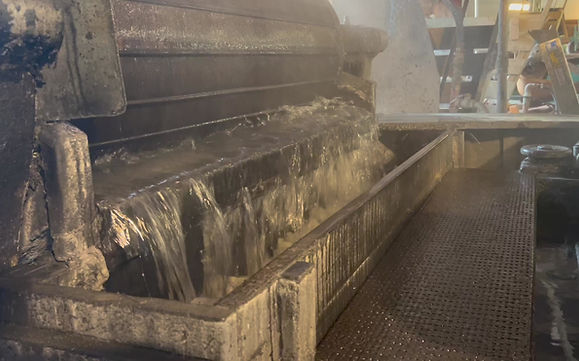
Title:
Year:
Material:
Fra Jord til Jord (from earth to earth)
Bruunshaab Papfabrik & Driftskontoret
June-Sep 2025, solo exhibtion at Driftskontoret
Birgitte Munk
Exhibited
Photos
Description
Collaboration
This exhibition presents the results of five months of research into the use of natural ochre pigment in the production of fiber cardboard and paper at Bruunshaab Papfabrik, Denmark. Bruunshaab is a century-old factory that still operates with the same machinery as it did 100 years ago. Until now, the colors in their production have always been synthetic.
Over the months, I explored the potential of using locally sourced ochre from Løvskal—both in its raw and burned forms—as a natural alternative. The exhibition, opening in June 2025, invites visitors to discover these possibilities while also reflecting on the intertwined histories and materiality of ochre and cardboard.
The exhibition took place at Driftskontoret at the factory. Divided into 3 parts it takes the spectator through an exstensiel journey of materials, crafts, industry, life and death.
2025
Fiber cardboard from recycled paper, Løvskal ochre, lignite from Abildaa
Part 1: From Earth
Ochre. Three years ago, Thomas Woltmann began working with ochre from Løvskal. Ochre is a natural earth pigment – a combination of various minerals, including iron. When heated, yellow ochre turns red, and at very high temperatures it can take on a violet hue. In 1965, the ochre works in Løvskal closed, but the current owner, Niels Jørn, has done a remarkable job of uncovering the remains of the old facility.Today, Thomas aims to rediscover and reinvent the properties of ochre as a pigment. As a pigment, ochre is lightfast and can be used in a wide range of applications – including cardboard.
Lignite. In 1970, Denmark’s lignite (brown coal) adventure came to an end, including in Abildå. Today, a local association in Abildå maintain the old machines, offer guided tours, and a few times a year, they fire up the equipment for live demonstrations. Thus, Abildå Lignite mine was reborn – not as a source of energy, but as a source of cultural heritage and community. Thomas hopes to give this material new life as a pigment.
Cardboard. Here at Bruunshaab, visitors can witness how cardboard is still produced according to traditional methods. The techniques and processes have remained unchanged for over a hundred years, and many of the machines date from the same period. At the same time, the box factory is running at full capacity, producing custom boxes to suit virtually any request – all while busloads of curious visitors are guided in large groups through the facility by staff and volunteers.Bruunshaab Paper Mill was once abandoned, but was rediscovered and revived by a group of passionate individuals.




Part 2: Transformation
Over a period of five months, Thomas investigated whether raw and burnt ochre, as well as lignite, could be used to dye cardboard. In this method, the pigment is mixed directly into the paper pulp, meaning the material is fully colored throughout – not just on the surface. This requires large amounts of pigment: approximately 1 kg per square meter of paperboard.
To make ochre and lignite usable as pigments, they first need to be processed. The raw materials are washed to remove impurities and then ground so that each pigment grain is 50 microns in size – 0.05 mm in diameter.
To achieve the best possible results, Thomas carried out a wide range of experiments and small-scale tests, which can be seen on table number two. Here, different types of burnt ochre and different pigment quantities were tested.
The outcome was three types of industrially dyed and produced cardboard: one using lignite, one using raw ochre, and one using burnt ochre. Additional experiments explored texture and marbling effects in the paper.
These tests show that dyeing cardboard with ochre is possible and could pave the way for a new, contemporary application of earth pigments in the 21st century – a material transformation and fusion of three local materials.







Part 3: To Earth
There was a time when people scattered burnt ochre around the dead. Perhaps they saw the color as magical—perhaps it helped guide the departed on their next journey. The red soil was a processed material, a burnt ochre. A soil that was eventually returned to its origin.
Today, the priest still casts earth onto the coffin—but not burnt earth. As a merging of ancient tradition and modern product, Thomas has designed two objects for the final journey, inspired by Bruunshaab current production of biodegradable cardboard urns.
This room symbolizes the final stage in the materials’ life cycle. Here they decay, here they are forgotten. In the center of the room, atop a wooden mound, stands a cardboard urn dyed with burnt ochre from Løvskal—an urn that will eventually decompose. On the pedestal by the wall lie boxes dyed with lignite, raw ochre, and burnt ochre. Inside them is pigment, ready to be scattered.
The boxes and urn were developed from historical traditions, but within the context of the factory, they are industrialized. On the wall behind, clips are shown and heard from both Løvskal and Bruunshaab—two places at different stages in their own life cycles.



With thanks to:
Driftskontoret
Bruunshaab Papfabrik
Statens Kunstfond
Viborg Kommune

